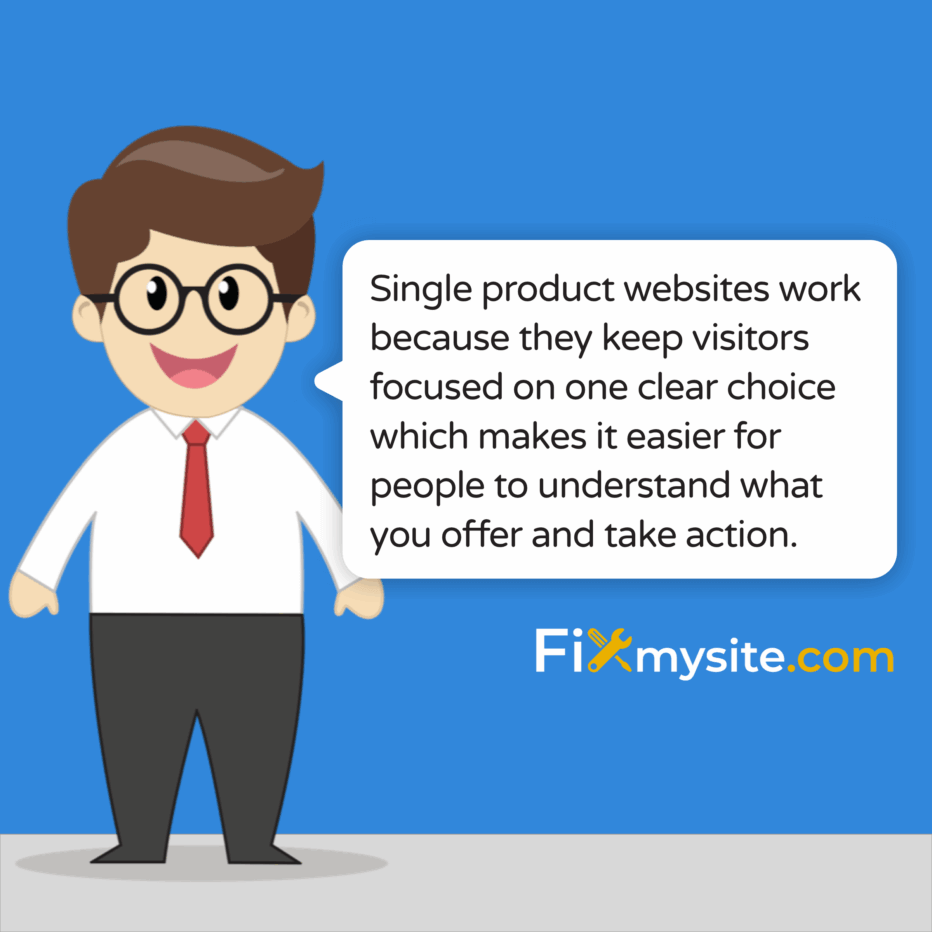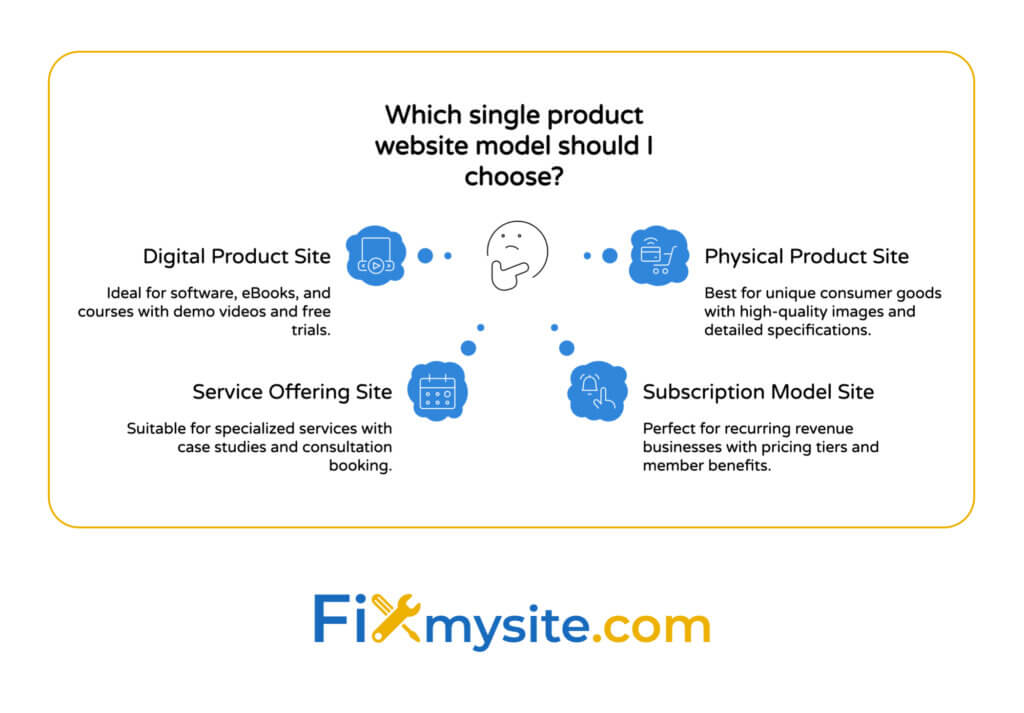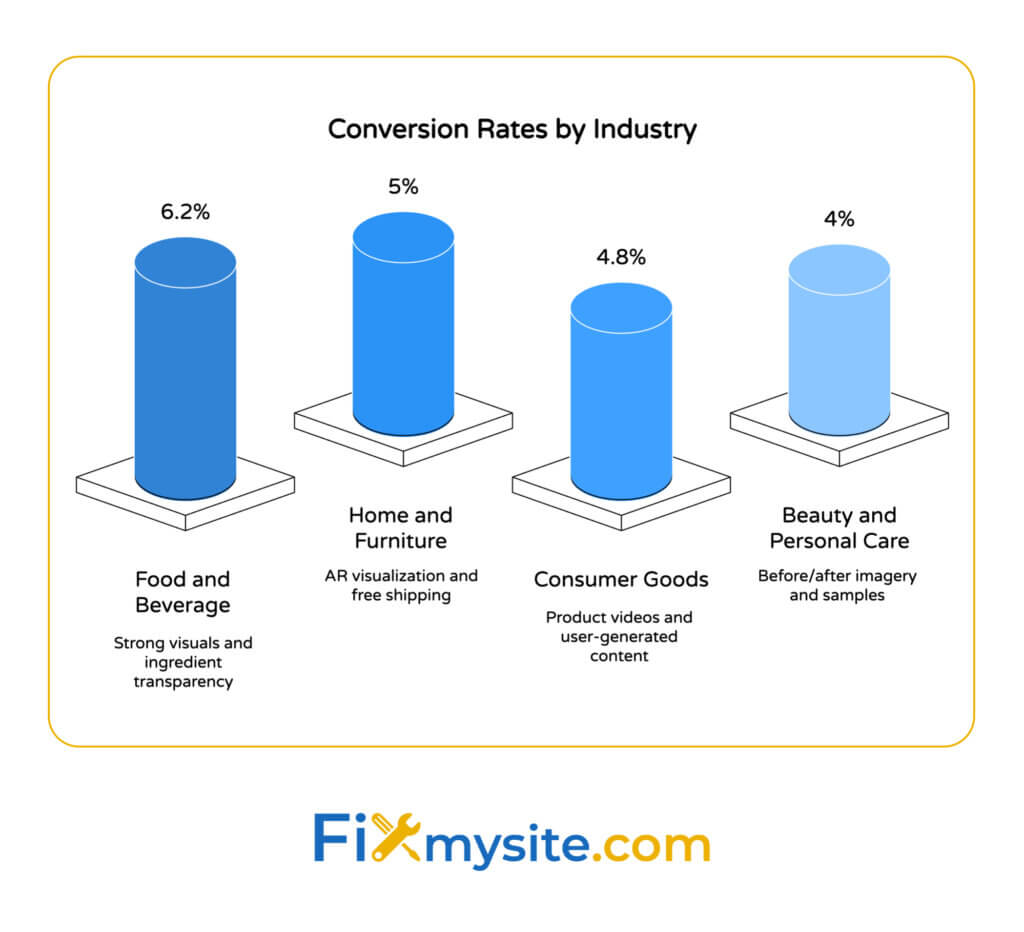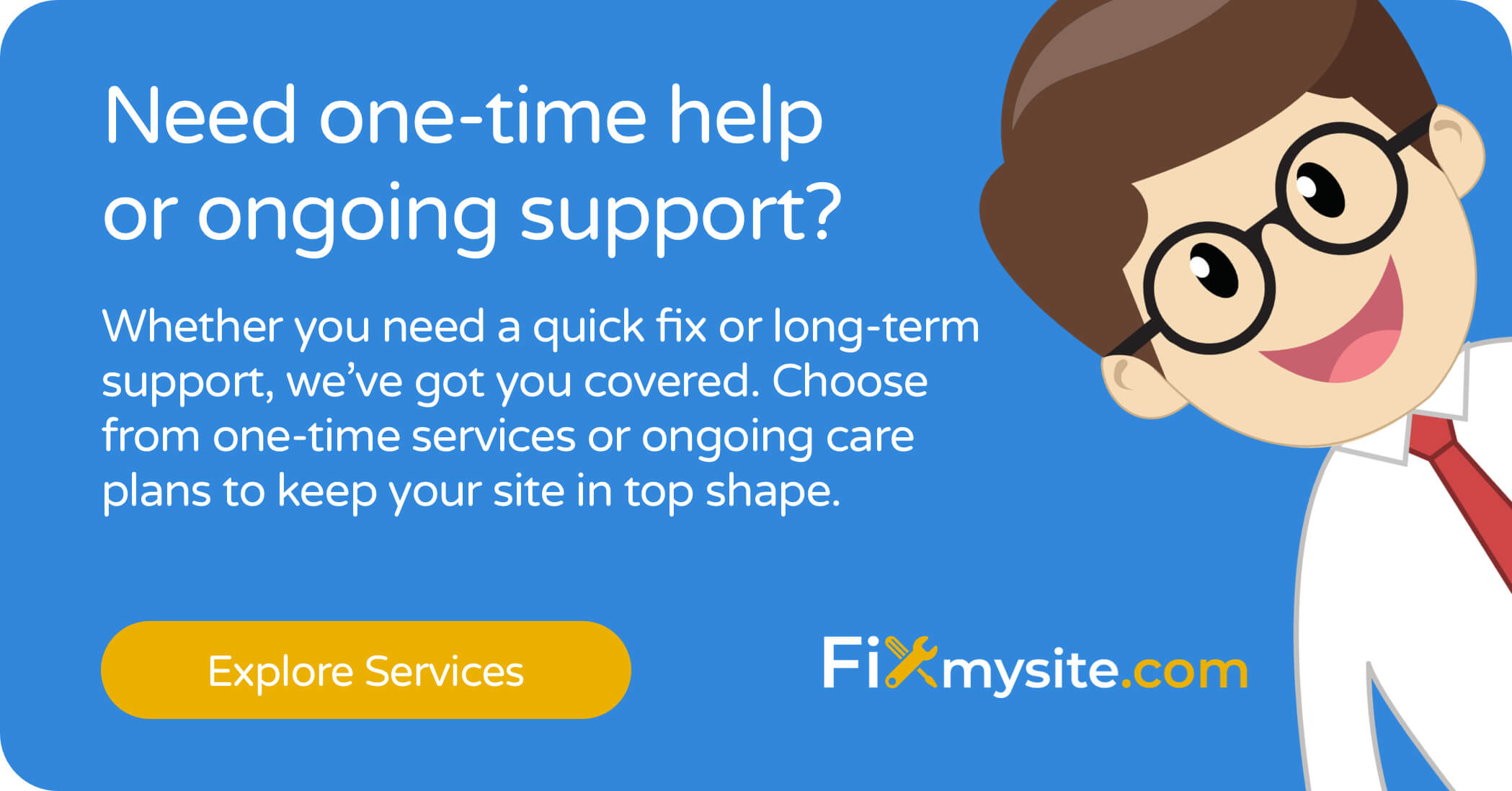
Creating a single product website that drives sales requires strategic planning and optimization. When done right, your product-focused site can achieve impressive conversion rates and generate consistent revenue. This comprehensive guide will show you exactly how to build a high-converting single product website using proven techniques and data-driven strategies.
What are Single Product Websites?
A single product website focuses exclusively on promoting and selling one main product or service. This focused approach allows you to craft messaging and design elements that perfectly highlight your offering. Many successful businesses use this strategy to maximize their conversion potential.
Single product websites differ from traditional multi-product stores in several ways. With all your resources focused on one offering, you can create a more compelling, conversion-optimized user experience. This targeted approach often leads to higher conversion rates when executed properly.

Let’s look at the main types of single product websites you might consider for your business:
| Website Type | Best For | Key Features | Example Industries |
|---|---|---|---|
| Digital Product Site | Software, eBooks, Courses | Demo videos, Free trials, Testimonials | SaaS, Education, Publishing |
| Physical Product Site | Unique consumer goods | High-quality images, Detailed specifications, Reviews | Consumer electronics, Specialty foods, Crafts |
| Service Offering Site | Specialized services | Case studies, Process breakdowns, Consultation booking | Consulting, Creative services, Technical support |
| Subscription Model Site | Recurring revenue businesses | Pricing tiers, Free trial offers, Member benefits | Software, Box subscriptions, Content memberships |
Each type requires specific optimization strategies. The best approach depends on your product type and target audience. Understanding your specific model helps you implement the right conversion techniques.

Essential Elements of High-Converting Product Websites
Creating a high-converting single product website requires certain essential elements. These components work together to guide visitors toward making a purchase. Let’s examine what makes these sites successful.
First, you need a clear, compelling value proposition. This should immediately communicate what your product does and why it matters. Your value proposition should appear prominently above the fold and speak directly to customer needs.
Social proof is another critical element. The average ecommerce conversion rate across all businesses is 1.81%. (Source: OptiMonk) However, sites with strong social proof elements often perform better. Include customer testimonials, reviews, and usage statistics to build trust.
Product visualization is equally important. High-quality photos, videos, and interactive elements help customers understand what they’re buying. This reduces purchase anxiety and improves conversion rates.

Let’s look at how conversion rates vary across different industries:
| Industry | Average Conversion Rate | Top Performer Rate | Key Success Factors |
|---|---|---|---|
| Food and Beverage | 6.2% | 10%+ | Strong visuals, Ingredient transparency, Reviews |
| Home and Furniture | 5% | 8%+ | AR visualization, Detailed dimensions, Free shipping |
| Consumer Goods | 4.8% | 7%+ | Product videos, User-generated content, Guarantees |
| Beauty and Personal Care | 4% | 6%+ | Before/after imagery, Samples, Ingredient lists |
These industry conversion rates show significant variation, with food and beverage leading at 6.2%. (Source: Blogging Wizard) Understanding your industry benchmarks helps set realistic goals for your site.
A strong call-to-action (CTA) is essential for converting visitors. Your CTA should be visually distinct, use action-oriented language, and create a sense of urgency. Position multiple CTAs throughout your page, always keeping one visible as users scroll.
Conversion-Focused Design Principles
Design directly impacts how visitors interact with your single product website. The right design choices can significantly boost your conversion rates. Let’s explore key principles that drive results.
Visual hierarchy guides visitors’ attention to important elements. Use size, color, and positioning to highlight your product, value proposition, and call-to-action buttons. This creates a natural flow toward conversion points.
Color psychology plays a subtle but powerful role. Different colors evoke specific emotions and responses. For example, blue builds trust, while orange and red create urgency. Choose colors that align with your brand and encourage desired actions.
White space helps prevent overwhelm. Giving elements room to breathe improves comprehension and focus. Cluttered designs confuse visitors and reduce conversion rates. Strategic white space makes important elements stand out.
- Contrasting CTA buttons – Make buttons stand out with colors that contrast with your background
- Directional cues – Use arrows, human gaze, or pointing elements to guide attention to key areas
- Consistent branding – Maintain visual consistency to build trust and recognition
- Mobile-friendly layout – Ensure all design elements work well on smaller screens
- F-pattern layout – Arrange important elements along the natural F-shaped reading pattern
Implementing these design elements can dramatically improve your conversion rate. The average desktop conversion rate is 3.9%, while mobile converts at just 1.8%. (Source: MobiLoud) Optimizing your design for both platforms is essential.
Simplicity should guide your design philosophy. Every element on your page should serve a purpose. Remove anything that doesn’t directly contribute to telling your product story or encouraging conversion.
Need Help With Your Website Design?
If you’re struggling with technical aspects of your WordPress site design, our on-demand WordPress support team can help you implement these conversion optimization strategies.
Optimizing Page Speed for Better Conversions
Page speed directly impacts your conversion rates. Visitors expect fast-loading websites. Even small delays can cause potential customers to leave before seeing your product. Let’s look at effective speed optimization techniques.
Image optimization is one of the most important factors. Large, unoptimized images slow down your site significantly. Compress images, use modern formats like WebP, and implement lazy loading to improve performance.
When building a WordPress single product site, we recommend implementing proper WordPress caching solutions to improve loading times. Caching stores static versions of your pages, reducing server processing time for each visitor.
Let’s examine how page speed affects conversion rates across different devices:
| Load Time | Desktop Conversion Impact | Mobile Conversion Impact | Recommended Solution |
|---|---|---|---|
| 1-2 seconds | Optimal performance | Strong performance | Maintain and monitor |
| 3-4 seconds | 10% decrease | 15% decrease | Basic optimization needed |
| 5-6 seconds | 25% decrease | 35% decrease | Comprehensive optimization required |
| 7+ seconds | 40%+ decrease | 50%+ decrease | Complete technical overhaul |
The table above shows the significant impact of loading time on conversion rates. Industry leaders suggest average ecommerce conversion rates are around 2.5% to 3%. (Source: Shopify) However, slow sites can perform far below these benchmarks.
Code optimization is equally important for page speed. Minify CSS and JavaScript files to reduce their size. Eliminate render-blocking resources and remove unnecessary third-party scripts. Each script you add creates additional loading time.
Why is my WordPress site loading slowly is a common question many site owners ask. Often, the culprit is poor hosting. Choose a quality hosting provider that offers solid performance. Consider managed WordPress hosting for better speed and support.
Mobile Optimization for Single Product Sites
Mobile optimization is no longer optional for single product websites. With more shoppers using smartphones for purchases, your site must perform flawlessly on mobile devices. Let’s explore key mobile optimization strategies.
First, adopt a mobile-first design approach. Design for the smallest screens first, then expand to larger displays. This ensures your most important elements work well on mobile. Desktop elements should enhance the already-solid mobile experience.
Touch elements need special attention on mobile. Buttons and links should be large enough to tap easily without zooming. Apple recommends touch targets of at least 44×44 pixels. Small, clustered links lead to frustration and abandoned purchases.
Simplified navigation is essential for mobile users. Complex menus that work on desktop often fail on smaller screens. Use a streamlined navigation structure that highlights your product and key conversion points.
- Test on multiple devices – Verify your site works across various screen sizes and browsers
- Optimize forms for mobile – Minimize form fields and use appropriate input types
- Enable autofill – Allow browsers to fill in personal information automatically
- Implement mobile payment options – Include Apple Pay, Google Pay, and other mobile wallets
Regional data shows mobile optimization is particularly important in certain markets. Great Britain leads with conversion rates of 4.1%, followed by the US at 2.5%. (Source: Blogging Wizard) These higher-performing regions typically have better mobile shopping experiences.
The concept of comprehensive WordPress speed optimization involves multiple technical approaches that are especially important for mobile users. Mobile connections are often slower than desktop, making optimization even more critical.

Conversion-Boosting Content Strategies
Your content strategy plays a crucial role in converting visitors. Effective content addresses customer questions, overcomes objections, and guides them toward purchase. Let’s explore high-converting content approaches.
Product descriptions should balance features and benefits. Features tell what your product does, while benefits explain why it matters to customers. Focus more on benefits to create emotional connections with potential buyers.
Use clear, concise language that speaks directly to your target audience. Avoid jargon unless your audience specifically expects it. Simple language improves comprehension and builds trust with visitors.
Let’s look at how different content elements impact conversion rates:
| Content Element | Average Conversion Impact | Implementation Difficulty | Best Practices |
|---|---|---|---|
| Product Videos | +80% conversion potential | Medium | Keep under 2 minutes, show product in use |
| Customer Testimonials | +50% conversion potential | Low | Include photo, name, and specific results |
| FAQ Sections | +30% conversion potential | Low | Address common objections, use actual customer questions |
| Comparison Charts | +25% conversion potential | Low | Compare to alternatives, highlight your advantages |
Storytelling creates emotional connections with your audience. Share the story behind your product, how it was developed, or how it has helped others. Emotional engagement drives purchasing decisions more effectively than facts alone.
FAQs address common objections before they become purchase barriers. Identify questions potential customers frequently ask and answer them clearly. This builds trust and removes hesitation from the buying process.
slow loading times can cause up to 40% of visitors to abandon your site, making speed optimization critical for content-heavy pages. Ensure your content loads quickly and doesn’t slow down the user experience.
Technical SEO for Single Product Websites
Technical SEO ensures your single product website is discoverable by search engines. Proper optimization helps attract organic traffic that can convert into customers. Let’s cover the essential technical aspects.
Schema markup is particularly important for product pages. Implementing product schema helps search engines understand your offering. This can lead to rich snippets in search results, which typically have higher click-through rates.
URL structure should be clean and descriptive. For a single product site, keep URLs short and include your main keyword. Avoid parameters and unnecessary subdirectories that complicate the URL.
- Implement canonical tags – Prevent duplicate content issues with proper canonicalization
- Optimize meta titles and descriptions – Include keywords and compelling call-to-actions
- Set up proper heading hierarchy – Use H1 for main title and H2/H3 for sections
- Create an XML sitemap – Help search engines discover and index your content
- Enable breadcrumb navigation – Improve user experience and SEO with clear path indicators
Page speed is a ranking factor for search engines. Top performing Shopify stores exceed 3.2% conversion rates, placing them in the top 20% of all stores. (Source: Shopify) These high-performing sites typically have excellent technical SEO implementation.
Technical SEO Assistance
Need help implementing these technical SEO strategies? Our team specializes in WordPress speed optimization and technical SEO improvements that boost both rankings and conversions.
Testing and Optimization Strategies
Continuous testing and optimization are essential for maximizing your conversion rate. No single product website is perfect from launch. Ongoing improvement leads to better results over time.
A/B testing allows you to compare different versions of your page to see which performs better. Test one element at a time to clearly understand what drives improvements. Common elements to test include headlines, CTAs, images, and pricing displays.
Heatmap analysis shows exactly how visitors interact with your page. This visual data reveals where people click, how far they scroll, and which elements get attention. Use these insights to optimize element placement and page structure.
Let’s examine a framework for ongoing conversion optimization:
| Optimization Phase | Key Activities | Tools to Consider | Expected Outcomes |
|---|---|---|---|
| Research | User surveys, Analytics review, Competitor analysis | Google Analytics, Hotjar, SurveyMonkey | Understanding user behavior and pain points |
| Hypothesis | Identify issues, Prioritize tests, Create test ideas | Excel, Trello, Optimizely | Structured testing plan with clear priorities |
| Implementation | A/B tests, Multivariate tests, User testing | Google Optimize, VWO, UserTesting | Validated improvements with statistical significance |
| Analysis | Results analysis, Implementation of winners, Documentation | Google Data Studio, Excel, Notion | Documented learnings and conversion improvements |
User testing provides qualitative feedback on your site. Watch real people navigate your website and listen to their thoughts. This often reveals issues that analytics alone might miss. Combine user testing with quantitative data for best results.
Conversion tracking must be properly set up to measure success. Define clear conversion goals in your analytics platform. Track not just purchases but also micro-conversions like email signups or product video views.
Conclusion
Creating a single product website that converts requires attention to multiple factors. From design and content to technical optimization and testing, each element plays an important role. The strategies outlined in this guide will help you build a high-performing product site.
Remember that conversion optimization is an ongoing process. Start with the fundamentals covered here, then continuously test and improve. Small, incremental improvements add up to significant conversion rate gains over time.
If you need help implementing these strategies on your WordPress site, our team at Fixmysite is ready to assist. We specialize in WordPress optimization, repairs, and performance tuning to help you achieve better conversion rates.
Get Expert WordPress Help
Our WordPress experts can help optimize your single product website for maximum conversions. Visit Fixmysite.com/support to learn how we can improve your site’s performance today.



